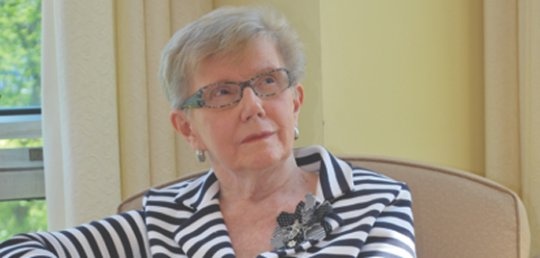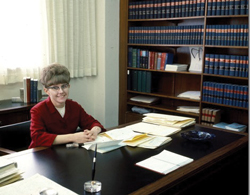
The trailblazer: Mary Hetherington
By Jane Doucet
Mary M. Hetherington (LLB’63) admits that she didn’t attend Dalhousie Law School because she always had a burning desire to become a lawyer. “My stock answer is that it’s a hereditary disease,” she says cheekily. Her father and brother were lawyers, and while they didn’t discourage her from pursuing her path, neither did they encourage her. One of only two women in her 1963 graduating class of 21 students, Hetherington believes her father and brother had what were then legitimate concerns that she would have a difficult time finding a job.
“There were few women lawyers at that time,” says Hetherington. “When I moved to Calgary after graduating, there was one woman in private practice, another in family court and me. Certainly firms had no interest in hiring women.” Hetherington’s mother, however, supported her daughter’s decision. “She was a teacher, but I think she would have liked to have been a lawyer.”
Born in Lacombe, Alta., in 1933, Hetherington earned a BA from Queen’s University in 1954; she worked as a secretary during the summers at her father’s law office in Lacombe, absorbing everything that was happening around her. After graduation, she spent six years in secretarial jobs before enrolling in Dalhousie Law School at the age of 27. “It was very exciting to be back at university,” she says. “I enjoyed the experience and the exposure to various aspects of the law.”
A journey of firsts
Admitted to the bar in the Province of Alberta in 1964, Hetherington practiced in Calgary with Shannon, Rowbotham and Cook for two years, then with Duncan L. McKillop until 1967, when she became a sole practitioner doing mainly criminal and domestic litigation. In 1978, she was appointed to the District Court of Alberta, making her Calgary’s first female judge. In 1982, she was appointed deputy judge of the Supreme Court of the Yukon; three years later, she was the first woman appointed to the Court of Appeal of Alberta, as well as the first woman appointed to the Court of Appeal in the Northwest Territories. In 1991, she was also appointed a deputy judge of the Supreme Court of the Northwest Territories; as a result, she sat as a trial judge in both the Yukon and the Northwest Territories.
With so many firsts on her CV, the temptation is to label Hetherington a pioneer, but she didn’t view it that way. “I never saw myself as some kind of role model or an advocate for women,” she says. “I wanted to practice law and be an advocate for people. If some of those people happened to be women, that was fine. But I wanted to avoid acting exclusively for women.”
The criminal cases Hetherington worked on, as a litigator and even more so as a judge, could be traumatic. “There were some high-profile murder cases, and for a new judge, jury trial is quite stressful,” she says. “It is the responsibility of the trial judge to ensure that only properly admissible evidence is heard by the jury, and that the charge to the jury is fair and correct in law.”
Challenges of this kind are what made Hetherington seriously consider leaving litigation to become a judge after she was approached to do so. “It had never occurred to me that I might become a judge,” she says. “The height of my ambition was to practice law.” Once she made the transition, however, she didn’t look back. “I didn’t miss litigating,” she says. “In that sense, it was a natural progression. I was still in the courtroom, just on the other side of the desk.”
Heading North
More appointments would follow between 1991 and 2002, including deputy judge of the Nunavut Court of Justice in Iqaluit (where she sat as a trial judge in every community to which the Court travelled on a regular basis) and the Nunavut Court of Appeal. “I very much enjoyed my time in Nunavut,” says Hetherington. “I did a quite a lot of work there even after I retired from the Court of Appeal. I loved it there, but it’s hard to articulate what makes it so great. I guess I’ve always been drawn to off-the-beaten-path places. It’s very beautiful, and pictures don’t do it justice. I also enjoyed my contact with the Inuit.”
In 2001, Hetherington retired from the Alberta Court of Appeal and joined ADR Chambers (Western Region), an alternative dispute group. The following year, she was appointed to the Criminal Injuries Review Board of Alberta. From 2003 to 2005, she was an adjudicator in the alternative dispute resolution process at the Indian Residential Schools Adjudication Secretariat.
Over the years, Hetherington was a guest lecturer at the University of Alberta and University of Calgary law schools, where she also judged moot courts. She has spoken frequently at seminars given by the courts, the Legal Education Society of Alberta, the National Judicial Institute and the Canadian Institute for the Administration of Justice. She has been an advocate for abused and disadvantaged women and seniors, serving on the Calgary Seniors’ Resource Society board and volunteering at the Tom Baker Cancer Centre. She is also a past honorary director of the Elizabeth Fry Society of Calgary and Discovery House, a second-stage shelter for abused women and their children.
Having retired earlier this year from such interesting yet time-consuming responsibilities and from working, Hetherington confesses that she’s “adjusting” to having free time (“I still feel like I should be writing something”), which she’s filling with learning to play bridge and upcoming travel to Italy. In fact, travelling is one of her passions; favourite past trips include the Arctic, the Antarctic, Southeast Asia, the Middle East, Africa and South America.
In 2011, Hetherington received the Order of Canada, yet she remains modest about both that and her myriad other career-related achievements. When pressed, she will say this: “I guess I’ve made a difference in some people’s lives. Women have told me that they were encouraged by the pioneering work I did in law. I was passionate about my work and I did my best. That was all I could do.”
This article originally appeared in the Winter 2013/14 issue of Hearsay Magazine.



